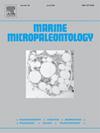钙质纳米化石Reticulofenestra oamaruensis的系统进化:南太平洋IODP U1553遗址微进化的一个例子
IF 1.5
4区 地球科学
Q2 PALEONTOLOGY
引用次数: 0
摘要
南大洋(Campbell高原)的IODP 378远征队在U1553遗址恢复了一个古近系沉积剖面,该剖面在晚始新世-早渐新世区间通过多个孔(a - E)取心。地层连续性和保存良好的钙质纳米化石为研究南大洋始新世/渐新世过渡(EOT)的生物地层标志Reticulofenestra oamaruensis的种系起源提供了机会。通过对奥马鲁河鼠及其近缘种克拉特拉网(Reticulofenestra clatrata)的生物特征和形态分析,揭示了克拉特拉鼠与奥马鲁河鼠之间的中间形态。这些过渡形态被标记为Reticulofenestra过渡形态1 (R. t1)和Reticulofenestra过渡形态2 (R. t2),它们与端元的大小不同,分别分为10-12 μm和12-14 μm两类。种内进化趋势显示,克拉特拉河鼠(R. clatrata)的尺寸逐渐增大(8 ~ 10 μm),经过以R. t1和R. t2为代表的中间步骤,最终形成oamaruensis(≥14 μm)。这两种形态都被纳入到R. oamaruensis的物种鉴定中,并在连续的层次上进入地层记录,从而划定了一个在SO生物地层学中有用的“谱系带”。在始新世/渐新世界线附近,克拉特拉河鼠和中大型奥马鲁河鼠消失。基于形态同源性、从克拉特拉河鼠到奥马鲁拉河鼠的逐渐增大的大小趋势、地层范围的连续性和相同的地理分布,我们发现了一种南方高纬度特有的种系菌株,其中克拉特拉河鼠为原型。本文章由计算机程序翻译,如有差异,请以英文原文为准。
Phyletic evolution of calcareous nannofossil species Reticulofenestra oamaruensis: An example of microevolution preserved at IODP Site U1553 (Southern Pacific Ocean)
The IODP Expedition 378 in the Southern Ocean (Campbell Plateau) recovered a Paleogene sedimentary section at Site U1553, cored through multiple holes (A - E) in the late Eocene-early Oligocene interval. Stratigraphic continuity and good preservation of calcareous nannofossils offered the opportunity to study the phyletic origin of Reticulofenestra oamaruensis, the biostratigraphic marker for the Eocene/Oligocene Transition (EOT) in the Southern Ocean (SO). We performed biometric and morphological analyses on R. oamaruensis and the related species Reticulofenestra clatrata, revealing intermediate morphotypes with characters between R. clatrata and R. oamaruensis. These transitional morphotypes, labeled Reticulofenestra transitional form 1 (R. t1) and Reticulofenestra transitional form 2 (R. t2), differ in size from the end members and are distinguished in two size categories: 10–12 μm and 12–14 μm respectively. The intraspecific evolutionary trend shows a gradual size increase of R. clatrata(8–10 μm) that, through intermediate steps represented by R. t1 and R. t2, leads to R. oamaruensis (≥14 μm). The two morphotypes are included in the species identification of R. oamaruensis and enter the stratigraphic record at successive levels, thus delineating a “lineage zone” useful in SO biostratigraphy. R. clatrata and medium – large R. oamaruensis disappear close to the Eocene/Oligocene Boundary. Based on the morphological homology, the progressively increasing size trend from R. clatrata to R. oamaruensis, their stratigraphic range continuity, and their same geographical distribution, we document a phyletic strain endemic to high southern latitudes, of which R. clatrata would represent the archetype.
求助全文
通过发布文献求助,成功后即可免费获取论文全文。
去求助
来源期刊

Marine Micropaleontology
地学-古生物学
CiteScore
3.70
自引率
15.80%
发文量
62
审稿时长
26.7 weeks
期刊介绍:
Marine Micropaleontology is an international journal publishing original, innovative and significant scientific papers in all fields related to marine microfossils, including ecology and paleoecology, biology and paleobiology, paleoceanography and paleoclimatology, environmental monitoring, taphonomy, evolution and molecular phylogeny. The journal strongly encourages the publication of articles in which marine microfossils and/or their chemical composition are used to solve fundamental geological, environmental and biological problems. However, it does not publish purely stratigraphic or taxonomic papers. In Marine Micropaleontology, a special section is dedicated to short papers on new methods and protocols using marine microfossils. We solicit special issues on hot topics in marine micropaleontology and review articles on timely subjects.
 求助内容:
求助内容: 应助结果提醒方式:
应助结果提醒方式:


